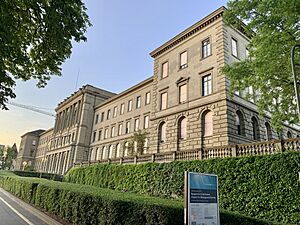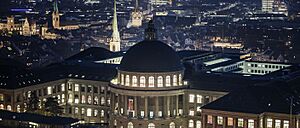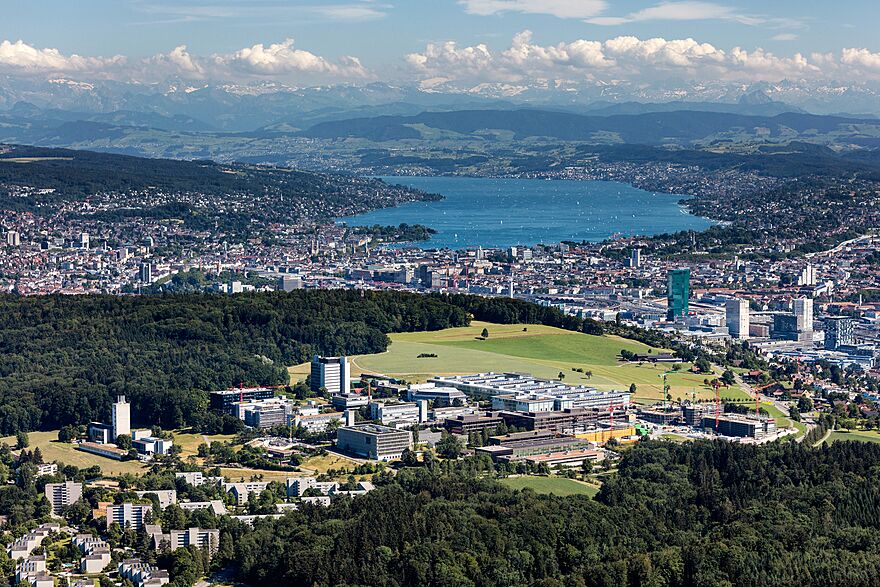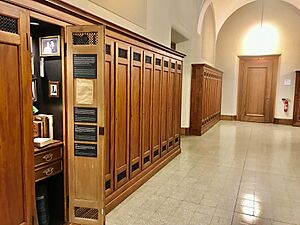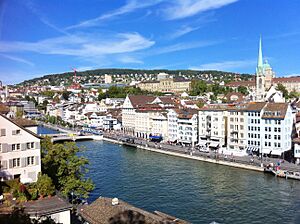ETH Zurich facts for kids
|
Eidgenössische Technische Hochschule Zürich
|
|
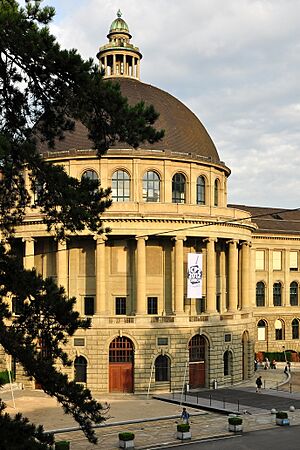
ETH Zurich main building
|
|
|
Other names
|
(Swiss) Federal Institute of Technology in Zurich, German: Polytechnikum (colloquially) |
|---|---|
|
Former name
|
Eidgenössische polytechnische Schule |
| Type | Public |
| Established | 1855 |
| Budget | CHF 1.896 billion (2021) |
| President | Joël Mesot |
| Rector | Günther Dissertori |
|
Academic staff
|
6,612 (including doctoral students, excluding 527 professors of all ranks) (full-time equivalents 2021) |
|
Administrative staff
|
3,106 (full-time equivalents 2021) |
| Students | 24,534 (headcount 2021) |
| Undergraduates | 10,642 |
| Postgraduates | 8,299 |
| 4,460 | |
|
Other students
|
1,133 |
| Address |
Rämistrasse 101
,
Zurich, Switzerland
47°22′35″N 8°32′53″E / 47.37639°N 8.54806°E |
| Campus | Urban |
| Language | German, English (Masters and upwards, sometimes Bachelor) |
| Colors | Black and white |
| Affiliations | CESAER, ENHANCE Alliance, EUA, IARU, IDEA League, LERU |
 |
|
ETH Zurich (German: Eidgenössische Technische Hochschule Zürich) is a top public university in Zurich, Switzerland. It was founded in 1854. The university mainly focuses on science, technology, engineering, and mathematics (STEM) subjects. ETH Zurich is known as one of Europe's best universities.
ETH Zurich is part of the ETH Domain, a group of universities and research centers in Switzerland. This group also includes its sister school, EPFL. As of 2023, ETH Zurich had over 25,000 students from more than 120 countries. About 4,400 of these students were working on their doctoral degrees.
Many famous people have studied or worked at ETH Zurich. This includes 22 Nobel laureates, like Albert Einstein. It also includes winners of the Fields Medal (for math), Pritzker Prize (for architecture), and the Turing Award (for computer science). ETH Zurich is also a founding member of important international university groups like the IDEA League and the International Alliance of Research Universities (IARU).
Contents
History of ETH Zurich
ETH Zurich was created on February 7, 1854, by the Swiss government. It started teaching its first classes on October 16, 1855. Back then, it was called a polytechnic institute. It had six main study areas: architecture, civil engineering, mechanical engineering, chemistry, forestry, and a department for math, natural sciences, literature, and social sciences.
People in Zurich still often call it Polytechnikum or just Poly. This comes from its original name, which means "federal polytechnic school." ETH Zurich is a "federal" school, meaning the Swiss government directly runs it.
In the early days, ETH Zurich shared buildings with the University of Zurich. From 1905 to 1908, the school changed its programs to be more like a real university. It was then allowed to give out doctoral degrees. The first doctorates were awarded in 1909. In 1911, it got its current name, Eidgenössische Technische Hochschule. Today, it has 16 different departments.
ETH Zurich, along with EPFL and four research institutes, forms the "ETH Domain." They work together on science projects.
Campuses of ETH Zurich
ETH Zurich has two main campuses: Zentrum and Hönggerberg. The Zentrum campus grew around the main building. This building was built between 1858 and 1864. It was outside the city back then, but now it's right in the city center.
As the city and university grew, ETH Zurich needed more space. So, a new campus was built from 1964 to 1976. This new campus is on the Hönggerberg, a hill on the edge of the city. The last big expansion of this new campus was finished in 2003.
Zentrum Campus: City Heart Location
The Zentrum campus has many buildings spread throughout the city of Zurich.
This campus is home to departments like:
- Mathematics
- Computer Science
- Humanities, Social and Political Sciences
- Information Technology and Electrical Engineering
- Mechanical and Process Engineering
- Environmental Systems Science
- Earth and Planetary Sciences
- Management, Technology, and Economics
- Health Sciences and Technology
The main building of ETH Zurich was designed by Gottfried Semper. He was a professor of architecture at ETH Zurich at the time. Semper used a special neoclassical style in his designs. The main building is right across from the University Hospital of Zurich. It is also next to the main building of the University of Zurich.
Hönggerberg Campus: Modern University Hub
The Hönggerberg campus is more like a traditional university campus. It has many university buildings and places for students to live.
This campus houses departments like:
- Architecture
- Civil, Environmental and Geomatic Engineering
- Materials
- Biology
- Chemistry and Applied Biosciences
- Physics
There is also a sports center called ASVZ. All students and staff can use it. It has a gym, beach volleyball court, football field, and martial arts rooms. In 2005, for ETH Zurich's 150th anniversary, a big project called "Science City" began. The goal was to make the Hönggerberg Campus an attractive and sustainable area.
Research and Education at ETH Zurich
Studying at ETH Zurich often starts with tough "base examinations" (Basisprüfungen). These are intense exams in your first year. They cover basic subjects like math, physics, and engineering. These exams help prepare students for more advanced research-focused courses. Students must pass these exams within two tries. In some math-heavy programs, 50% to 60% of students might not pass.
For doctoral students (PhD candidates), the focus is on hands-on research. PhD students are hired as paid employees in professors' labs. They do their own research and help with teaching. Many departments also have special graduate schools. These schools help students work together on research and cooperate with other universities, like the University of Zurich.
ETH Zurich's research mainly focuses on STEM fields. It has several important research centers.
ETH AI Center: Exploring Artificial Intelligence
The ETH AI Center is the main place for artificial intelligence (AI) research at ETH Zurich. It is part of the European Laboratory for Learning and Intelligent Systems (ELLIS). The center also works closely with the Max Planck Institute for Intelligent Systems. They fund research and guide doctoral students together.
Swiss National Supercomputing Center: Powerful Computers
The Swiss National Supercomputing Center (CSCS) is part of ETH Zurich. It is located in Lugano-Cornaredo. This center provides powerful computers for scientists in Switzerland. In 2024, it launched the Alps Supercomputer. This computer has over 10,000 special graphics cards. It is one of the largest academic supercomputers in the world.
ETH Laboratory of Ion Beam Physics: Studying Materials
The ETH Laboratory of Ion Beam Physics (LIB) is a physics lab in Science City. It uses special techniques with ion beams. These techniques are used in many areas. This includes archeology, earth sciences, life sciences, material sciences, and fundamental physics.
Spin-off Companies: From Ideas to Businesses
ETH Zurich helps students and researchers turn their ideas into new companies. These are called "spin-offs" or "start-ups." As of 2022, over 520 spin-off companies had been created from ETH Zurich.
Rankings and Reputation of ETH Zurich
| University rankings | |
|---|---|
| Global – Overall | |
| ARWU World | 20 (2023) |
| QS World | 7 (2026) |
| THE World | 11 (2024) |
| Regional – Overall | |
| THE Europe | 4 (2023) |
ETH Zurich is well-known for its work in chemistry, mathematics, physics, and computer science. Twenty-two Nobel laureates have been connected to ETH Zurich. The most recent is Didier Queloz, who won the Nobel Prize in Physics in 2019. Albert Einstein is probably the most famous person to have studied there.
ETH Zurich is ranked 7th worldwide in the QS World University Rankings 2025. It is 11th worldwide in the Times Higher Education World University Rankings 2024. It also ranked 20th worldwide in the Academic Ranking of World Universities 2023. In the 2025 QS Europe rankings, ETH Zurich was ranked 1st in Europe.
In specific subjects, ETH Zurich is also highly ranked. In the 2024 QS World University Rankings by subject, it was in the top 10 globally for architecture, engineering and technology, and natural sciences. It was ranked first worldwide in earth and marine sciences, geology, and geophysics.
Student Life at ETH Zurich
Tuition and Financial Help
ETH Zurich is a public university, so its tuition fees are low. They are about CHF 730 per semester for all students. Starting in the autumn semester of 2025, tuition fees for international students will be CHF 2190 per semester. The university also offers scholarships based on merit (how well you do in school) and need (if you need financial help).
Student Associations and Clubs
ETH Zurich has over 100 student clubs and associations. The biggest one is VSETH (Verband der Studierenden an der ETH). This group is like an umbrella for all the smaller student clubs. It has many committees, including a Student Sustainability Committee and an ETH Model United Nations group. These associations often organize events for students.
The largest career fair on campus is the Polymesse. Students organize this event. Many student associations also hold career fairs for students in their specific study areas. VSETH also represents students to the university. They work with ETH to make the student experience better.
ETH Juniors is another student group. It connects students with companies. It offers services for both students and businesses as a student-run consulting group.
Sports and Activities
The Academic Sports Association of Zurich (ASVZ) offers more than 120 sports. The biggest yearly sports event is the SOLA-Stafette. This is a relay race with 14 sections, covering a total distance of 140 kilometers.
Student Project House: Innovation Hub
In 2017, ETH Zurich created a "Student Project House." This place helps students work on their own projects and come up with new ideas. It has "makerspaces" and co-working areas. These spaces have tools for woodworking, metalworking, and electronics. They also have many 3D-printers that students can use for a small fee.
The makerspaces are run by students. They also have a shop where students can buy small items like resistors. A new space is expected to open on the Hönggerberg campus in 2024.
Engineering Competitions
Several student teams at ETH Zurich take part in engineering competitions:
- The Swiss Academic Spaceflight Initiative (ARIS) works on space-related technologies. They develop sounding rockets for the Spaceport America Cup.
- The AMZ - Academic Motorsports Association is ETH Zurich's Formula Student team. They design and build race cars.
- Swissloop is a newer team working on a hyperloop system.
Traditions at ETH Zurich
The Polyball is a very large decorated ball (a type of dance party) in Europe. It happens every year in the main building of ETH. Students and former students organize it. This tradition has been going on since the 1880s.
There is a friendly competition between ETH Zurich and the nearby University of Zurich. This rivalry started in 1951. Every year, there is a rowing match between teams from the two schools on the Limmat river.
ETH Zurich also hosts many regular conferences. One important event is the annual Wolfgang Pauli Lectures. These lectures honor former ETH Zurich Professor Wolfgang Pauli. Since 1962, famous speakers, including 24 Nobel laureates, have given talks on natural sciences at this conference.
Famous People from ETH Zurich
ETH Zurich has been home to many famous scientists. This includes Albert Einstein and John von Neumann. More than twenty Nobel laureates either studied at ETH Zurich or won the Nobel Prize for work they did there. Other alumni have won top awards like the Fields Medal (for math), Pritzker Prize (for architecture), and Turing Award (for computer science). Besides academic achievements, many ETH Zurich alumni have also been Olympic medalists and world champions in sports.
-
Albert Einstein, 1921 Nobel Prize in Physics for the photoelectric effect.
-
John von Neumann, a brilliant thinker in computing, quantum physics, and game theory.
-
Wolfgang Pauli, 1945 Nobel Prize in Physics for the Pauli-Exclusion principle.
-
Fritz Haber, 1918 Nobel Prize in Chemistry for the Haber-Bosch Process.
-
Niklaus Wirth, 1984 Turing Award winner for the programming language Pascal.
-
Alessio Figalli, 2018 Fields Medal for his work on partial differential equations.
Related Organizations
Collegium Helveticum: A Think Tank
The Collegium Helveticum is an advanced research institute. It is supported by ETH Zurich, the University of Zurich, and the Zurich University of the Arts. It focuses on research that crosses different subjects and acts like a think tank. Researchers are chosen for five years to work together on a specific topic. From 2016 to 2020, their focus was on "digital societies."
ETH Zurich Foundation: Supporting the University
The ETH Zurich Foundation is a separate non-profit organization. Its goal is to raise money to support specific institutes, projects, professors, and students at ETH Zurich. It gets donations from companies, other foundations, and individuals. This foundation helps fund things like:
- New institutes, such as the Wyss Translational Center Zurich
- Additional professorships (teaching positions)
- The Rössler Prize
- Pioneer fellowships
- Excellence scholarships
Military Academy: Training Officers
The Military Academy trains officers for the Swiss Armed Forces. The scientific part of this academy is connected to ETH Zurich. Other parts, like training and assessment, are managed by the Swiss government's defense department.
See also
 In Spanish: Escuela Politécnica Federal de Zúrich para niños
In Spanish: Escuela Politécnica Federal de Zúrich para niños
- EPFL
- Engineering
- List of universities in Switzerland
- Science and technology in Switzerland
- 2000-watt society
- Disney Research
- e-rara.ch
- Swiss Federal Institute for Vocational Education and Training



